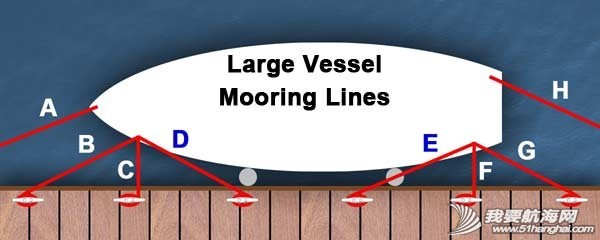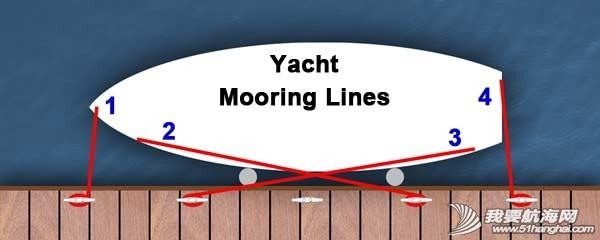本帖最后由 Yana 于 2014-5-2 21:46 编辑
Mooring Lines and Names
Mooring lines on large ships are nearly always made of a high-modulus polyethylene (HMPE) such as Vectran® or Dyneema®. These ropes float and their minimal elasticity reduces risk of injury due to "snap-back" in the event of a breakage. Each line serves a specific purpose. On large vessels two lines often run in parallel ("doubled up") for safety. The following diagram shows a typical arrangement:

Large Ship Mooring Lines
A:Bow Line
B:Forward Bow Spring
C:Forward Breast Line
D:After Bow Spring
E:Forward Quarter Spring
F:Quarter Breast Line
G:After Quarter Spring
H:Stern Line
On yachts mooring lines are more likely to be made of nylon, or polyester (Dacron® or Terylene®). By contrast with mooring a large vessel, distances are usually small and movements due to waves and tide are proportionately greater. Moreover, because far fewer lines are used, it is critical to understand their purpose:
The Breast Lines prevent rotation and should run roughly at 90o to the dock. To gain length, they should be led from the farthest part of the boat: the bow itself (or the outer hull of a catamaran) and from the far quarter of the stern.
The Spring Lines prevent fore and aft movement and should run nearly parallel to the dock and may cross each other to obtain an optimal lie.
Direction: The Bow Spring may be led forwards and the Stern Spring aft, but MUST lead in opposite directions.

Yacht Mooring Lines
1:Bow Breast Line
2:Bow Spring Line
3:Stern Spring Line
4:Stern Breast Line

网站上有动画和视频
http://www.animatedknots.com/ind ... w.animatedknots.com
http://www.animatedknots.com/use ... w.animatedknots.com
|